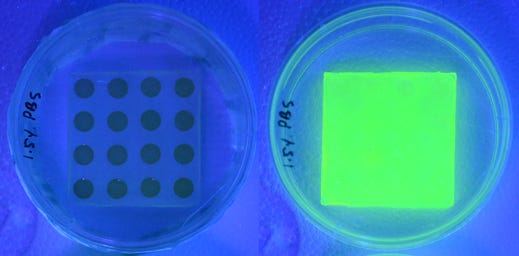How a Glowing Bandage Could Tackle the Superbug Epidemic
January 4, 2016
A new 'smart' bandage prototype could be used to alert healthcare professionals to the early signs of bacterial infections commonly found in wounds. The technology could improve wound treatments while also preventing the unnecessary use of antibiotics, and, by extension, the worsening superbug epidemic.
Kristopher Sturgis
|
Image on left shows bandage before it contact bacterial toxins. The image on the right shows how it looks when activated by bacterial toxins. |
Researchers from Bath University in the United Kingdom initially wanted to come up with improved treatment for wound care in burn victims. But they have developed a product that could address the problem of antibiotic resistance.
They have developed a color-changing bandage that consists of a hydrogel polymer matrix that helps to control wound moisture levels. The bandage has been infused with tiny nanocapsules that contain fluorescein, a dye that at high concentration is non-fluorescent -- but as it is diluted becomes fluorescent.
Toby Jenkins, Associate Professor in Biophysical Chemistry at the university and principal investigator on the technology, says that the dressing will allow clinicians to quickly identify infections without removing it. This would not only allow for quicker treatment, but could alleviate the unnecessary use of antibiotics.
"The fundamental need is to assist clinicians in making a decision about a patient's condition," Jenkins says. "Is the wound infected? If so, antibiotics and/or wound disinfection might be needed. Currently infection appears to be over-diagnosed, meaning it is suspected more often than it is actually present, leading to antibiotic overuse."
The idea of antibiotic overuse is one that is gathering momentum, as health officials seek to understand the growing presence of antibiotic resistant bacteria, or "superbugs," containing the mcr-1 gene. The consensus being that the more we use antibiotics, the more resistant bacteria will become towards them. Which is why limiting the use of antibiotics whenever possible is of the utmost importance, something this 'smart' bandage could accomplish.
To understand the science behind the bandage, it's important to understand how bacterial infections form inside the wound.
"All wounds have some bacteria within them," Jenkins says. "In a wound that becomes critically colonised with bacteria, the immune system is overwhelmed. This might be the case with a 'dirty wound' such as a battlefield injury, or a large wound like a burn. As bacteria colonise such a wound, they start to attach to tissue and form a biofilm. Toxins are secreted from the biofilm, which degrades tissue and provides food for the bacteria, and allows the infection to propagate."
This is when the nanocapsules of the smart bandage kick in. The tiny nanocapsules begin to get broken down by the toxins secreted from the biofilm, releasing the fluorescein dye into the hydrogel. There the dye becomes diluted by water within the hydrogel, resulting in a clear color change that is visible to the naked eye.
The group initially focused on burn wounds, as the genesis of the project began with a collaboration with burn clinicians. However, Jenkins believes there could be a general utility of the technology that includes consumer-purchased dressings.
"We don't foresee manufacturing costs too high," Jenkins says. "The problems we now are working with are working out how to upscale manufacture for mass sterile production and packaging, as well as obtaining safety and regulatory consent for first human use, which we hope will be in 2019."
While that may still be a few years away, the problem of antibiotic resistance remains a growing concern in the medical community. In the meantime, medical device manufacturers and suppliers continue to develop new antimicrobial technologies, all in an effort to stem the tide of superbugs growing immune to antibiotics. Technologies like this 'smart' bandage will only help as they could potentially limit the use of antibiotics across the board.
Brush up on latest medical device research breakthroughs at MD&M West, February 9-11 at the Anaheim Convention Center in Anaheim, CA. |
Like what you're reading? Subscribe to our daily e-newsletter.
About the Author(s)
You May Also Like



